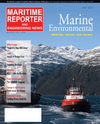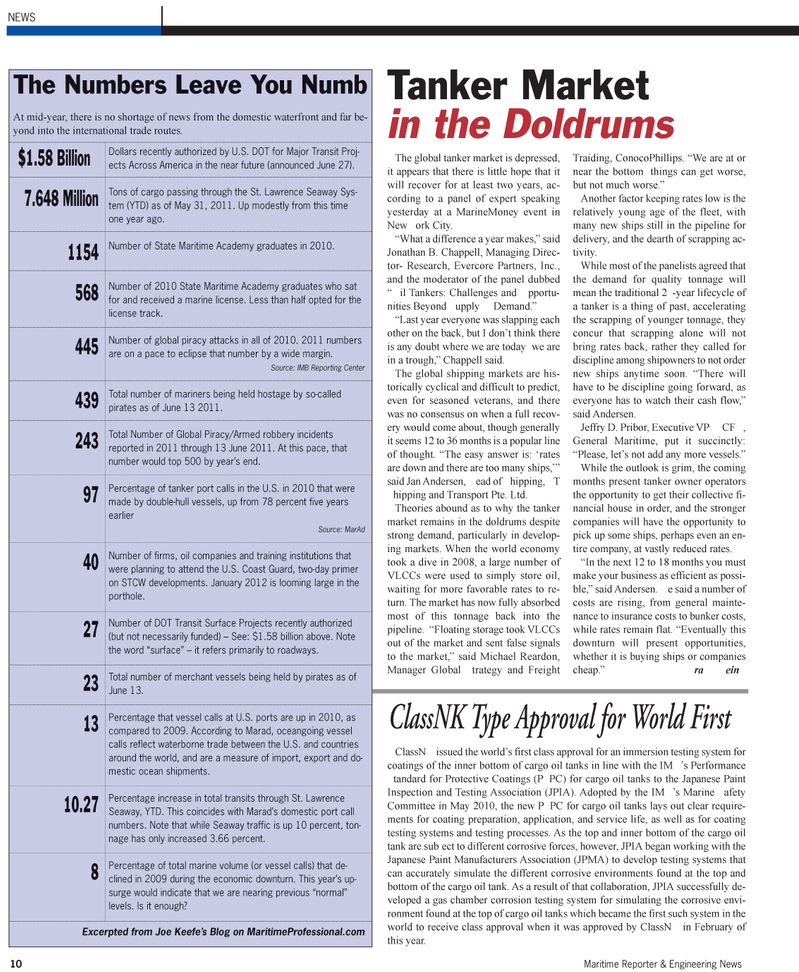
Page 10: of Maritime Reporter Magazine (July 2011)
The Green Ship Edition
Read this page in Pdf, Flash or Html5 edition of July 2011 Maritime Reporter Magazine
NEWSThe global tanker market is depressed, it appears that there is little hope that itwill recover for at least two years, ac- cording to a panel of expert speaking yesterday at a MarineMoney event in New ork City. ?What a difference a year makes,? said Jonathan B. Chappell, Managing Direc-tor- Research, Evercore Partners, Inc., and the moderator of the panel dubbed?il Tankers: Challenges and pportu- nities Beyond upply Demand.? ?Last year everyone was slapping each other on the back, but I don?t think there is any doubt where we are today we are in a trough,? Chappell said. The global shipping markets are his- torically cyclical and difficult to predict, even for seasoned veterans, and there was no consensus on when a full recov- ery would come about, though generally it seems 12 to 36 months is a popular lineof thought. ?The easy answer is: ?ratesare down and there are too many ships,?? said Jan Andersen, ead of hipping, T hipping and Transport Pte. Ltd. Theories abound as to why the tanker market remains in the doldrums despite strong demand, particularly in develop- ing markets. When the world economy took a dive in 2008, a large number of VLCCs were used to simply store oil,waiting for more favorable rates to re- turn. The market has now fully absorbed most of this tonnage back into thepipeline. ?Floating storage took VLCCs out of the market and sent false signals to the market,? said Michael Reardon, Manager Global trategy and Freight Traiding, ConocoPhillips. ?We are at or near the bottom things can get worse, but not much worse.? Another factor keeping rates low is the relatively young age of the fleet, with many new ships still in the pipeline for delivery, and the dearth of scrapping ac- tivity. While most of the panelists agreed thatthe demand for quality tonnage willmean the traditional 2-year lifecycle of a tanker is a thing of past, accelerating the scrapping of younger tonnage, they concur that scrapping alone will notbring rates back, rather they called for discipline among shipowners to not order new ships anytime soon. ?There will have to be discipline going forward, as everyone has to watch their cash flow,? said Andersen.Jeffry D. Pribor, Executive VP CF, General Maritime, put it succinctly:?Please, let?s not add any more vessels.? While the outlook is grim, the comingmonths present tanker owneroperators the opportunity to get their collective fi- nancial house in order, and the stronger companies will have the opportunity to pick up some ships, perhaps even an en- tire company, at vastly reduced rates. ?In the next 12 to 18 months you must make your business as efficient as possi- ble,? said Andersen. e said a number of costs are rising, from general mainte-nance to insurance costs to bunker costs, while rates remain flat. ?Eventually this downturn will present opportunities, whether it is buying ships or companies cheap.? raein 10Maritime Reporter & Engineering News The Numbers Leave You Numb At mid-year, there is no shortage of news from the domestic waterfront and far be- yond into the international trade routes. $1.58 Billion7.648 Million1154568445439243974027231310.278Dollars recently authorized by U.S. DOT for Major Transit Proj- ects Across America in the near future (announced June 27). Tons of cargo passing through the St. Lawrence Seaway Sys- tem (YTD) as of May 31, 2011. Up modestly from this time one year ago.Number of State Maritime Academy graduates in 2010.Number of 2010 State Maritime Academy graduates who satfor and received a marine license. Less than half opted for the license track.Number of global piracy attacks in all of 2010. 2011 numbersare on a pace to eclipse that number by a wide margin. Source: IMB Reporting Center Total number of mariners being held hostage by so-called pirates as of June 13 2011.Total Number of Global Piracy/Armed robbery incidents reported in 2011 through 13 June 2011. At this pace, that number would top 500 by years end. Percentage of tanker port calls in the U.S. in 2010 that were made by double-hull vessels, up from 78 percent five years earlier Source: MarAd Number of firms, oil companies and training institutions thatwere planning to attend the U.S. Coast Guard, two-day primer on STCW developments. January 2012 is looming large in the porthole. Number of DOT Transit Surface Projects recently authorized (but not necessarily funded) ? See: $1.58 billion above. Notethe word surface? ? it refers primarily to roadways. Total number of merchant vessels being held by pirates as of June 13.Percentage that vessel calls at U.S. ports are up in 2010, as compared to 2009. According to Marad, oceangoing vessel calls reflect waterborne trade between the U.S. and countries around the world, and are a measure of import, export and do- mestic ocean shipments. Percentage increase in total transits through St. Lawrence Seaway, YTD. This coincides with Marads domestic port call numbers. Note that while Seaway traffic is up 10 percent, ton- nage has only increased 3.66 percent. Percentage of total marine volume (or vessel calls) that de- clined in 2009 during the economic downturn. This years up- surge would indicate that we are nearing previous normal? levels. Is it enough?Excerpted from Joe Keefes Blog on MaritimeProfessional.com Tanker Market in the DoldrumsClassNK Type Approval for World First ClassN issued the world?s first class approval for an immersion testing system for coatings of the inner bottom of cargo oil tanks in line with the IM?s Performance tandard for Protective Coatings (PPC) for cargo oil tanks to the Japanese Paint Inspection and Testing Association (JPIA). Adopted by the IM?s Marine afety Committee in May 2010, the new PPC for cargo oil tanks lays out clear require- ments for coating preparation, application, and service life, as well as for coatingtesting systems and testing processes. As the top and inner bottom of the cargo oil tank are subect to different corrosive forces, however, JPIA began working with the Japanese Paint Manufacturers Association (JPMA) to develop testing systems that can accurately simulate the different corrosive environments found at the top and bottom of the cargo oil tank. As a result of that collaboration, JPIA successfully de- veloped a gas chamber corrosion testing system for simulating the corrosive envi- ronment found at the top of cargo oil tanks which became the first such system in the world to receive class approval when it was approved by ClassN in February of this year.

 9
9

 11
11
